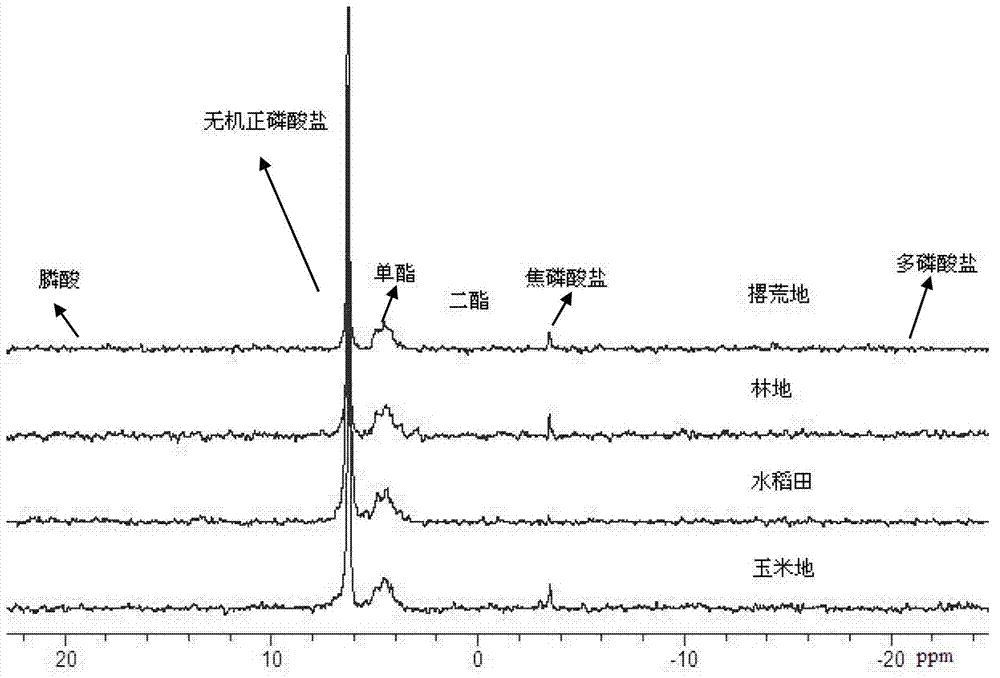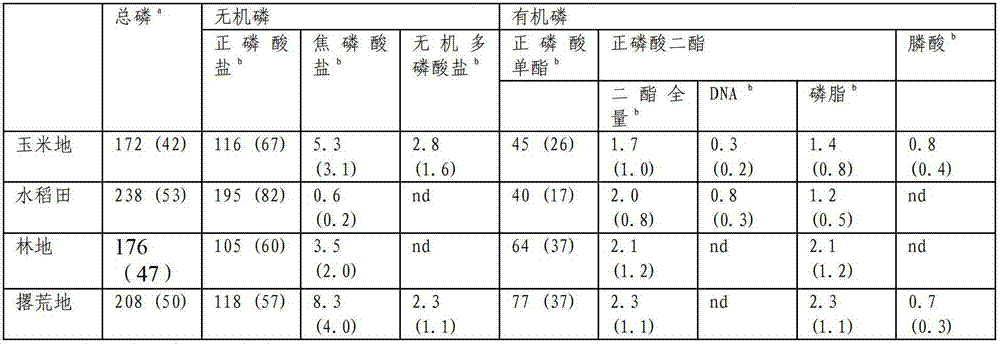Method for detecting phosphorus component in soil by using BD-liquid 31PNMR (pulse nuclear magnetic resonance)
A phosphorus component and soil technology, which is applied in the preparation of test samples and analysis by nuclear magnetic resonance, etc., can solve the problems of low soil phosphorus extraction rate, large chemical shift deviation, and low spectral resolution, and achieve an increase Effects of Accuracy, Increased Accuracy, Increased Resolution
- Summary
- Abstract
- Description
- Claims
- Application Information
AI Technical Summary
Problems solved by technology
Method used
Image
Examples
Embodiment 1
[0021] Take 2.5g of air-dried soil samples passed through a 2mm sieve under different land use patterns (cornfield, paddy field, woodland and abandoned land), add 50ml NaOH-EDTA (preparation method: weigh 10g NaOH and dissolve in 600mL deionized water, Then add 18.612g Na 2 EDTA, the final volume was adjusted to 1000mL) after the mixture was shaken, it was centrifuged at 10000*g for 30 minutes. The supernatant after the centrifugation of the extract was taken 5-10ml each time, so that the total volume reached about 40ml, and then freeze-dried immediately. Before freeze-drying, add 5% sodium bicarbonate-dithionite buffer solution (preparation method: weigh 1.8482gNaHCO 3 with 3.8309gNa 2 S 2 o 4 Dilute to 200mL with deionized water and shake well, then quickly freeze it with a rotary freezer at a temperature below -40°C for about 20 minutes, so that the extract can be evenly frozen on the bottom of the freeze-drying bottle. Quickly transfer the frozen freeze-dried vial to ...
Embodiment 2
[0033] Take 2.5g of air-dried soil samples passed through a 2mm sieve from grassland soil (grazing, weeding) under different management methods, and add 50ml of NaOH-EDTA (preparation method: weigh 10g of NaOH and dissolve it in 600mL of deionized water, then add 18.612g of NaOH-EDTA 2 EDTA, the final volume was adjusted to 1000mL) after the mixture was shaken, it was centrifuged at 10000*g for 40 minutes. The supernatant after the centrifugation of the extract was taken 5-10ml each time, so that the total volume reached about 40ml, and then freeze-dried immediately. Before freeze-drying, add 4% sodium bicarbonate-dithionite buffer solution (preparation method: weigh 1.8482g NaHCO 3 with 3.8309g Na 2 S 2 o 4 Dilute to 200mL with deionized water) and shake well, then quickly freeze it with a rotary freezer at -45°C for about 30 minutes, so that the extract is evenly frozen on the bottom of the freeze-drying bottle. Quickly transfer the frozen freeze-dried vial to a freeze-d...
PUM
 Login to View More
Login to View More Abstract
Description
Claims
Application Information
 Login to View More
Login to View More - R&D
- Intellectual Property
- Life Sciences
- Materials
- Tech Scout
- Unparalleled Data Quality
- Higher Quality Content
- 60% Fewer Hallucinations
Browse by: Latest US Patents, China's latest patents, Technical Efficacy Thesaurus, Application Domain, Technology Topic, Popular Technical Reports.
© 2025 PatSnap. All rights reserved.Legal|Privacy policy|Modern Slavery Act Transparency Statement|Sitemap|About US| Contact US: help@patsnap.com



